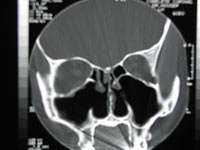Turbinectomy
Turbinectomy is a procedure in which some or all of the turbinate bones in the nasal passage are removed, generally to relieve nasal obstruction.[1] In most cases, turbinate hypertrophy is accompanied by some septum deviation, so the surgery is done along with septoplasty.[2]
| Turbinectomy | |
|---|---|
 CT scan of the nose after total bilateral turbinectomy | |
| ICD-9-CM | 21.6 |
Indications
A turbinectomy is mainly performed for turbinate hytrophy, when the turbinates are swollen and enlarged. Mainly things can contribute to this, including allergies, environmental irritants, a deviated septum, among others.[3]
Procedure
Traditional methods
There are many different techniques, such as electrocautery, cryotherapy (cryoturbinectomy), laser vaporization and turbinoplasty. They all require general anesthesia.[2][4]
Radiofrequency Ablation
The use of Radiofrequency Ablation has shown to be a safer alternative procedure, being performed under an outpatient procedure, using lidocaine for a local anesthesia. It does not alter epithelial structure nor function. It has no postoperative pain, bleeding, or crusting; although it can cause some temporary nasal blockage or rhinorrhea due to resulting inflammation.[5]
Complications
Empty nose syndrome, which is one form of atrophic rhinitis, is a condition that can develop as a result of turbinate surgery or other surgeries that have an impact on the turbinates. It is a rare condition in which people whose nasal passages are clear following a turbinectomy experience a number of symptoms, including feelings of nasal obstruction, nasal dryness, and crusting, a sensation of being unable to breath, among others.
References
- Ye T, Zhou B. Update on surgical management of adult inferior turbinate hypertrophy. Curr Opin Otolaryngol Head Neck Surg. 2015 Feb;23(1):29-33. PMID 25565284
- Mabry, Richard L. (Jan 1988). "Inferior Turbinoplasty: Patient Selection, Technique, and Long-Term Consequences". Otolaryngology–Head and Neck Surgery. 98 (1): 60–66. doi:10.1177/019459988809800111. ISSN 0194-5998. PMID 3124053.
- Fischer, J. Keith; Frothingham, Scott. "What to Expect with a Turbinectomy". healthline. Healthline Media. Retrieved 15 August 2019.
- Elwany, Samy; Harrison, Robert (Jan 1990). "Inferior turbinectomy: Comparison of four techniques". The Journal of Laryngology & Otology. 104 (3): 206–209. doi:10.1017/S0022215100112290. ISSN 0022-2151. PMID 2187941.
- Coste, André; Yona, Laurent; Blumen, Marc; Louis, Bruno; Zerah, Francoise; Rugina, Michel; Peynègre, Roger; Harf, Alain; Escudier, Estelle (May 2001). "Radiofrequency Is a Safe and Effective Treatment of Turbinate Hypertrophy". The Laryngoscope. 111 (5): 894–899. doi:10.1097/00005537-200105000-00025. ISSN 0023-852X. PMID 11359172.